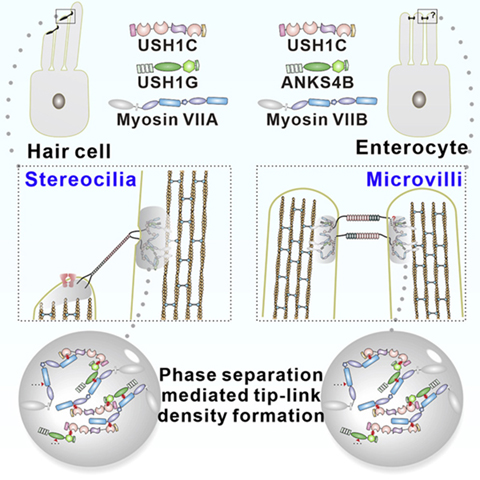
Hair cell stereocilia convert mechanical signals (sound waves) into electrical signals (the opening of ion channels depolarizes cells to form receptor potentials) when hearing occurs. The structure of stereocilia is maintained by tip-link densities formed by the cadherin family. In Usher Syndrome, a hereditary deafness disease, such an arrangement of the stereocilia is disordered. Prof. Mingjie Zhang published in Cell Reports that a point mutation of Myo7a (Myosin VIIa) found in Usher syndrome patients leads to disruption of the hair cell tip-link protein complex formation through liquid-liquid phase separation. There are protein-dense regions at the upper and lower end insertion sites of the tip-link called known as the upper tip link density (UTLD) and lower tip link density (LTLD), respectively. The UTLD is composed of the proteins encoded by the three pathogenic genes of the Usher syndrome (Myo7a, Ush1c, and Ush1g).
The research team previously discovered that the microvilli on the surface of the small intestine, which are very similar to the shape of the stereocilia, also have a tip-link formed by the cadherin family. They also discovered that these proteins and the UTLD of the stereocilia are highly homologous (Myosin VIIb, ANKS4B, and USH1C). First, the researchers decided to show that Myosin VIIb, USH1C and ANKS4B can form protein aggregates spontaneously through the phase separation mechanism under physiological conditions (low protein concentration, normal salt concentration, and pH value). The team followed up by demonstrating that the MYO7A/USH1C/USH1G complex can also undergo phases separation under the same condition proving that the UTLD protein complex in stereocilia uses the same mechanism to form protein aggregates.
Due to a large number of disease-causing point mutations in Myo7a in patients with Usher syndrome, the researchers have shown that these disease-causing point mutations all affect the occurrence of phase separation, which may lead to disorganization of the UTLD in stereocilia. This explains the disease pathogenesis of Usher’s syndrome and provides potential therapeutic targets in the future.
He Y, Li J, Zhang M. Myosin VII, USH1C, and ANKS4B or USH1G Together Form Condensed Molecular Assembly via Liquid-Liquid Phase Separation. Cell Rep. 2019 Oct 22;29(4):974-986.e4. doi: 10.1016/j.celrep.2019.09.027.